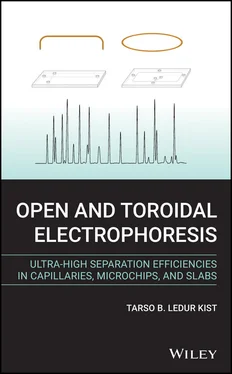Tarso B. Ledur Kist - Open and Toroidal Electrophoresis
Здесь есть возможность читать онлайн «Tarso B. Ledur Kist - Open and Toroidal Electrophoresis» — ознакомительный отрывок электронной книги совершенно бесплатно, а после прочтения отрывка купить полную версию. В некоторых случаях можно слушать аудио, скачать через торрент в формате fb2 и присутствует краткое содержание. Жанр: unrecognised, на английском языке. Описание произведения, (предисловие) а так же отзывы посетителей доступны на портале библиотеки ЛибКат.
- Название:Open and Toroidal Electrophoresis
- Автор:
- Жанр:
- Год:неизвестен
- ISBN:нет данных
- Рейтинг книги:4 / 5. Голосов: 1
-
Избранное:Добавить в избранное
- Отзывы:
-
Ваша оценка:
Open and Toroidal Electrophoresis: краткое содержание, описание и аннотация
Предлагаем к чтению аннотацию, описание, краткое содержание или предисловие (зависит от того, что написал сам автор книги «Open and Toroidal Electrophoresis»). Если вы не нашли необходимую информацию о книге — напишите в комментариях, мы постараемся отыскать её.
The exact expressions of separation efficiency, resolution, peak capacity, and many other performance indicators of the open and toroidal layouts are presented and compared.
Featuring numerous illustrations throughout,
offers chapters covering: Solvents and Buffer Solutions; Fundamentals of Electrophoresis; Open Layout; and Toroidal Layout. Confronting Performance Indicators is next, followed by chapters on High Voltage Modules and Distributors; Heat Removal and Temperature Control; and Detectors. The book finishes with an examination of the applications of Toroidal Electrophoresis.
The first book to offer a detailed account of Toroidal Electrophoresis—written by one of its creators
Compares the toroidal layouts with the well-established open layouts of the three most used platforms (Capillary, Microchip, and Slab) Provides solutions to many of the experimental issues arising in electromigration techniques and discusses the voltage distributors and detectors that are compatible with the toroidal layouts Richly illustrated with a large number of useful equations showing the relationships between important operational parameters and the performance indicators
is aimed at method developers and separation scientists working in clinical analysis, and food analysis, as well as those in pharmacology, disease biomarker applications, and nucleic acid analysis using the Capillary, Microchip, or slab Platform. It will also benefit undergraduate and graduate students of inorganic analytical chemistry, organic analytical chemistry, bioanalysis, pharmaceutical sciences, clinical sciences, and food analysis.

 ) and with much higher precision as more parameters of
) and with much higher precision as more parameters of  (with
(with  ) become available.[8]
) become available.[8] and
and  . They are defined as:
. They are defined as:
 is the activity of the species
is the activity of the species  . The activity of water is approximately constant at a given temperature and with the low solute concentrations normally used in the ESTs. Therefore, it is assumed that
. The activity of water is approximately constant at a given temperature and with the low solute concentrations normally used in the ESTs. Therefore, it is assumed that  . Equivalently, the conjugated acid BH +of base B, produced by the equilibrium reaction H 2O + BH + ⇌ B + H 3O +, has the following acid ionization constants:
. Equivalently, the conjugated acid BH +of base B, produced by the equilibrium reaction H 2O + BH + ⇌ B + H 3O +, has the following acid ionization constants:
 , where
, where  .
. ranges defined for very strong (
ranges defined for very strong (  ), strong (
), strong (  ), medium, weak, and very weak acids are poorly defined. Nevertheless, it is safe to say that acids with a
), medium, weak, and very weak acids are poorly defined. Nevertheless, it is safe to say that acids with a  of between 4 and 10 are weak acids and that acids with
of between 4 and 10 are weak acids and that acids with  can be considered as very weak acids. The opposite occurs for bases, as for a base to be very strong the
can be considered as very weak acids. The opposite occurs for bases, as for a base to be very strong the  of the conjugated acid BH +( equation 1.15) must be above 14 (
of the conjugated acid BH +( equation 1.15) must be above 14 (  ), with strong bases exhibiting
), with strong bases exhibiting  . Similar to weak acids, weak bases also exhibit
. Similar to weak acids, weak bases also exhibit  of between 4 and 10; however, in this case the very weak bases exhibit
of between 4 and 10; however, in this case the very weak bases exhibit  .
. significantly changes with temperature for some functional groups:
significantly changes with temperature for some functional groups:  , where
, where  is expected to be a smooth and slowly varying function of temperature. The
is expected to be a smooth and slowly varying function of temperature. The  of the great majority of amines decreases with temperature, while carboxylic acids exhibit a much smaller change, usually negative, but there are some exceptions and it depends on the temperature range. These temperature sensitivities have important practical implications for method development within the field of ESTs, as they affect the mobility of the analytes and the pH of the buffers.[9–11] Moreover, they are used to promote cyclic band compression in the toroidal layouts, which is an interesting way to get some control of band spreading along the separation mediums (see Appendix G).
of the great majority of amines decreases with temperature, while carboxylic acids exhibit a much smaller change, usually negative, but there are some exceptions and it depends on the temperature range. These temperature sensitivities have important practical implications for method development within the field of ESTs, as they affect the mobility of the analytes and the pH of the buffers.[9–11] Moreover, they are used to promote cyclic band compression in the toroidal layouts, which is an interesting way to get some control of band spreading along the separation mediums (see Appendix G). –pH diagrams are one of the most commonly used tools to visualize the concentration of chemical species, showing the concentration of each species at every pH in the
–pH diagrams are one of the most commonly used tools to visualize the concentration of chemical species, showing the concentration of each species at every pH in the  range (which is the maximum range used in ESTs). Figure 1.4shows the
range (which is the maximum range used in ESTs). Figure 1.4shows the  –pH diagram of a triprotic acid (0.1 M citric acid in an aqueous solution), which is a complex acid because its successive ionizations produce many species. In Figure 1.4only the most concentrated species can be seen, as the curves of the most diluted species (with
–pH diagram of a triprotic acid (0.1 M citric acid in an aqueous solution), which is a complex acid because its successive ionizations produce many species. In Figure 1.4only the most concentrated species can be seen, as the curves of the most diluted species (with  M) run too close to the line at
M) run too close to the line at  M to be observed. Nevertheless, many detectors (fluorescence and potentiometric) are able to detect species down to
M to be observed. Nevertheless, many detectors (fluorescence and potentiometric) are able to detect species down to  M and even lower concentrations. Therefore, sometimes it is desirable to visualize the concentration profiles of species within lower concentration ranges. p
M and even lower concentrations. Therefore, sometimes it is desirable to visualize the concentration profiles of species within lower concentration ranges. p  –pH diagrams are ideal for this as they show
–pH diagrams are ideal for this as they show  as a function of pH. Figure 1.5shows the same case as studied in Figure 1.4(
as a function of pH. Figure 1.5shows the same case as studied in Figure 1.4(  –pH diagram of citric acid at the initial concentration of
–pH diagram of citric acid at the initial concentration of  M), but it is now represented as a p
M), but it is now represented as a p  –pH diagram.
–pH diagram.










